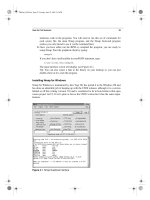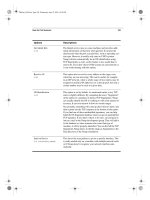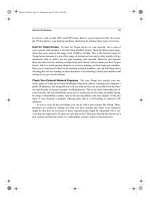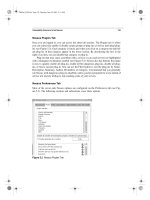Open Source Security Tools : Practical Guide to Security Applications part 12 pps
Bạn đang xem bản rút gọn của tài liệu. Xem và tải ngay bản đầy đủ của tài liệu tại đây (179.93 KB, 10 trang )
Port Scanners 89
were to open two browsers at the same time, your computer would create two separate
port numbers to connect on for each browser session, and the server would track them as
separate connections.
Just because a packet is labeled for port 80, nothing is stopping it from having data
other than Web traffic. The port number system depends on a certain “honesty” from the
machines it is communicating with, and that’s where the trouble can come in. In fact,
many applications such as instant messaging and peer-to-peer software programs, which
might normally be blocked at a company’s firewall, will flout this convention and sneak
through on port 80. Most firewalls will allow traffic on port 80 because they are configured
to allow Web access for users behind the firewall.
When a port is exposed on a computer, it receives all traffic being sent to the port,
legitimate nor not. By sending malformed packets or packets with too much or incorrectly
formatted data, people can sometimes crash the underlying application, redirect the flow
of code inside the application, and gain access to that machine illicitly. This is called a
buffer overflow, and these make up a large percentage of the security holes that exist
today.
Table 4.1 Common Server Ports
Common Port
Number Protocol Service
21 FTP File Transfer Protocol (control port)
22 SSH Secure Shell
23 Telnet Telnet
25 SMTP Mail service
53 DNS Domain name resolution
79 Finger Finger
80 HTTP Web service
135–139 NetBIOS Windows network communications
443 SSL Secure Web service
Howlett_CH04.fm Page 89 Wednesday, June 23, 2004 11:53 PM
90 Chapter 4 • Port Scanners
Buffer overflows happen when application programmers don’t properly code their
programs to handle data that “overflows” the memory space allotted to input variables.
When the program receives input that exceeds the allotted buffer, it can override internal
program control and thereby give a hacker access to system-level resources.
This used to be a very technical task that only the most experienced code hackers
could attempt. But you don’t have to be a high-level programmer to perform this kind of
break-in anymore. There are programs available that automatically perform these buffer
overflows with point-and-click ease.
Almost all programs of any size usually have some of these errors inside them. Mod-
ern software that runs into the millions of lines of code is just too complex to keep this
from happening. Maybe once whole generations of programmers have been retrained to
automatically write secure code, this problem will lessen or go away. Until then, you have
to keep a close eye on what applications or ports are showing on your network. These
ports are potential “windows” into your servers and workstations through which hackers
can launch their malicious code into your computers. Since this is where most security
exploits happen, it is very important to understand what is going on at this level on your
various servers and machines. You can do this easily and accurately with a type of soft-
ware called a
port scanner
.
Overview of Port Scanners
Port scanners, simply enough, poll a set of TCP or UDP ports to see if an application
answers back. If it receives a response, this means there is some application listening on
that port number. There are a possible 65,535 TCP ports, and the same number of ports are
available for the UDP protocol. Port scanners can be configured to scan all possible ports,
or just the commonly used ones (those below 1,024), to look for servers. A good reason to
do a complete scan of all possible ports is that network-aware Trojan horses and other
nasty software often run on uncommon ports high up in the range in order to avoid detec-
tion. Also, some vendors don’t stick as closely to the standards as they should and put
server applications on high port numbers. A full scan will cover all the possible places that
applications can be hiding, although this takes more time and eats up a little more band-
width.
Port scanners come in many different flavors, from very complex with lots of different
features to those with minimal functionality. In fact, you can perform the functions of a
port scanner yourself manually. You can use Telnet to do this, one port at a time. Simply
connect to an IP address and add the port number like this:
telnet 192.168.0.1:80
This command uses Telnet to connect to the machine. The number after the colon (on
some implementations of Telnet you just leave a space between the IP address and the port
number) tells Telnet to use port 80 to connect instead of the standard Telnet port of 22.
Rather than the normal Telnet prompt you get on the defaultTelnet port, you’ll connect to
Howlett_CH04.fm Page 90 Wednesday, June 23, 2004 10:24 PM
Overview of Port Scanners 91
the Web server if one is running on that machine. When you press Enter you will get the
first response from a Web server to a browser. You’ll see the HTTP header information,
which is normally processed by your browser and hidden from view. It will look some-
thing like the output shown in Listing 4.1.
Listing 4.1 HTTP Response to a TCP connection
GET / HTTP
HTTP/1.1 400 Bad Request
Date: Mon, 15 Mar 2004 17:13:16 GMT
Server: Apache/1.3.20 Sun Cobalt (Unix) Chili!Soft-ASP/3.6.2
mod_ssl/2.8.4 OpenSSL/0.9.6b PHP/4.1.2 mod_auth_pam_external/0.1
FrontPage/4.0.4.3 mod_perl/1.25
Connection: close
Content-Type: text/html; charset=iso-8859-1
<!DOCTYPE HTML PUBLIC "-//IETF//DTD HTML 2.0//EN">
<HTML><HEAD>
<TITLE>400 Bad Request</TITLE>
</HEAD><BODY>
<H1>Bad Request</H1><P>
Your browser sent a request that this server could not understand
Request header field is missing colon separator.<P>
<PRE>
/PRE>
<P>
</BODY></HTML>
You can do this with any open port, but you won’t always get anything intelligible
back. Basically this is what port scanners do: they attempt to establish a connection and
look for a response.
Some port scanners also try to identify the operating system on the other end. They do
this by performing what is called
TCP
fingerprinting
. Although TCP/IP is a standard for
network communications, every vendor implements it slightly differently. These differ-
ences, although they don’t normally interfere with communications, show up in the
response they give to any stimulus such as a ping or an attempted TCP connection. Thus,
the digital signature of a ping response from a Windows system looks different from the
response from a Linux system. There are even differences between versions of operating
systems. See Listing 4.2 for an example of the TCP fingerprint for Windows ME, 2000,
and XP.
Howlett_CH04.fm Page 91 Wednesday, June 23, 2004 10:24 PM
92 Chapter 4 • Port Scanners
Listing 4.2 Windows TCP Fingerprints
# Windows Millennium Edition v4.90.300
# Windows 2000 Professional (x86)
# Windows Me or Windows 2000 RC1 through final release
# Microsoft Windows 2000 Advanced Server
# Windows XP professional version 2002 on PC Intel processor
# Windows XP Build 2600
# Windows 2000 with SP2 and long fat pipe (RFC 1323)
# Windows 2K 5.00.2195 Service Pack 2 and latest hotfixes
# XP Professional 5.1 (build 2600) all patches up to June 20,
2004
# Fingerprint Windows XP Pro with all current updates to May 2002
Fingerprint Windows Millennium Edition (Me), Win 2000, or WinXP
TSeq(Class=RI%gcd=<6%SI=<23726&>49C%IPID=I%TS=0)
T1(DF=Y%W=5B4|14F0|16D0|2EE0|402E|B5C9|B580|C000|D304|FC00|FD20|FD
68|FFFF%ACK=S++%Flags=AS%Ops=NNT|MNWNNT)
T2(Resp=Y|N%DF=N%W=0%ACK=S%Flags=AR%Ops=)
T3(Resp=Y%DF=Y%W=5B4|14F0|16D0|2EE0|B5C9|B580|C000|402E|D304|FC00|
FD20|FD68|FFFF%ACK=S++%Flags=AS%Ops=MNWNNT)
T4(DF=N%W=0%ACK=O%Flags=R%Ops=)
T5(DF=N%W=0%ACK=S++%Flags=AR%Ops=)
T6(DF=N%W=0%ACK=O%Flags=R%Ops=)
T7(DF=N%W=0%ACK=S++%Flags=AR%Ops=)
PU(DF=N%TOS=0%IPLEN=38%RIPTL=148%RID=E%RIPCK=E|F%UCK=E|F%ULEN=134%
DAT=E)
What looks like unintelligible gibberish at the bottom is the unique settings that Win-
dows uses when it connects via TCP. By comparing the TCP response received from a
machine to a database of known TCP fingerprints, you can make a reasonable guess at the
operating system on the other end.
This method isn’t perfect. Sometimes the port scanner program gets it wrong because
some operating system vendors cannibalize or reuse parts of other systems (UNIX systems
in particular) when building a TCP stack. This causes the port scanner to think it is the OS
they borrowed the TCP stack from. Also, there are odd operating systems like switches,
printers, and network appliances that may not be in the signature database.
If people are scanning your network with less than honorable intentions in mind, this
provides them with valuable information. Knowing the operating system and version can
be a good starting point for figuring out what angles and exploits to try. This is a very good
reason to regularly scan your network to see what ports are showing open on your systems.
Then you can go through and close up unnecessary ports and lock down those that must
stay open.
Howlett_CH04.fm Page 92 Wednesday, June 23, 2004 10:24 PM
Considerations for Port Scanning 93
Considerations for Port Scanning
When planning to do port scanning of any network, keep in mind that this activity is very
network intensive. Scanning tens of thousands of ports in a short amount of time puts lot
of traffic on the network. If your scanning machine is very fast and it is scanning on an
older 10Mbps network, this can significantly affect the network’s performance. Over the
Internet, it is less of an issue because the scanning will be limited by the size of the con-
nections in between; however, you could still degrade the performance of a busy Web
server or mail server. In extreme cases, you might even take machines down.
When using these tools in any fashion, always make sure you have the permission of
the owner of the hosts you are scanning. The legality of port scanning is a gray area (you
are not actually breaking in, just performing network interrogation). However, your boss
might not care about the fine points if you take the corporate network down. And before
you decide to go out and scan a few of your favorite Web sites just for fun, keep in mind
that your ISP may have something in your Internet terms of service contract prohibiting
this kind of activity. Web site operators routinely file abuse complaints against the ISPs of
repeat offenders. So unless you want to get fired or have your ISP connection terminated,
get written permission from either your superior (when doing it for a company) or your
client/volunteer (if doing against a third party). Appendix D has a standard letter agree-
ment for getting permission from an intended scan target that is a good starting point to
cover your bases legally.
Even when you have permission, you should consider what the effect of scanning
will be on the target network. If it’s a heavily used network, you should do your scans at
night or during low usage periods. Some scanners have the ability to throttle back the rate
they throw packets onto the network so that it doesn’t affect the network as much. This
will mean your scan will take longer but will be much more network friendly.
Certain devices, such as firewalls and some routers, are now smart enough to recog-
nize port scans for what they are. Iptables can be configured to do this using the multiport
option and setting the priority flag. The machines can respond to port scans by slowing
down the rate of response for each successive poll. Eventually your scan could spool out
into forever. Sometimes you can trick the machine on the other end by randomizing the
order the ports are scanned or by stretching out your ping rate. Some devices will fall for
this, but others won’t. You just have to experiment to find out what works.
Uses for Port Scanners
Once you have permission to scan, you need to consider what your goal is in scanning
your network.
Network Inventory
Not sure exactly how many machines you have running? Want to know the IP addresses of
all your servers? Ports scanners offer a quick way to scan a range of addresses and find all
Howlett_CH04.fm Page 93 Wednesday, June 23, 2004 10:24 PM
94 Chapter 4 • Port Scanners
the live machines on that segment. You can even use the Nlog tool (discussed later in this
chapter) to log this into a database and create useful reports.
Network/Server Optimization
A port scanner will show you all the services currently running on a machine. If it is a
server machine, it is likely that there are many programs running, but you may not be
aware that some of these services are running. They may not be needed for the primary
function of the machine. Remember, the more services that are running, the more insecure
it is. And all these programs can slow down the performance of a heavily loaded server.
Things like extraneous Web servers, FTP servers, or DNS servers can take processor
cycles away from the main function of the box. Port scanning your servers and then going
through and optimizing them can give you an immediate increase in speed and response
times.
Finding Spyware, Trojan Horses, and Network Worms
Regular Web surfers will often pick up little programs from Web sites that try to track their
behavior or send custom pop-up ads to their computer. These programs are known as
spy-
ware
because they often try to track the user’s activities and may report this data back to a
central server. These programs are usually benign, but enough of them can dramatically
slow down a user’s performance. Also, they are often not well written and can interfere
and crash other programs. They also can present opportunities for hackers looking for
weak spots.
Another class of network-aware software that you definitely don’t want on your net-
work is the
Trojan horse
. These programs are specifically designed for those intent on
breaking into networks. Just like the Trojan horse of Greek lore, these programs allow
hackers and crackers a back door into your network, usually advertising their presence via
an open network port. Trojan horses can be notoriously hard to track down even if you are
using anti-virus software. They don’t always set off anti-virus scanners, and sometimes the
only thing that shows they are there is an open network port. Once inside a computer, most
Trojan horses try to communicate outwards to let their creator or sender know they’ve
infected a machine on these ports. Table 4.2 lists the most prevalent Trojan horses and
their port numbers. Many of the port numbers are easily recognizable from the clever
arrangements of numbers (for example, NetBus is 54,321, and Back Orifice is 31,337,
which stands for “elite” in the numbers used for letters in hacker code). Trojan horses tend
to run on high number ports with unusual, unrecognizable port numbers, although some
really wily Trojans try to run on low-level reserved ports to masquerade as a conventional
service.
Network Worms
are a particularly nasty type of virus. They are often network-aware
and open up ports on the host computer. Network Worms use the network to spread and as
such sometimes show up on network scans. A port scan can be a valuable backup to anti-
virus protection against these threats.
Howlett_CH04.fm Page 94 Wednesday, June 23, 2004 10:24 PM
Uses for Port Scanners 95
Looking for Unauthorized or Illicit Services
Regulating what employees run on their computers is a tough task. While you can limit
their access to floppy and CD-ROM drives using domain security polices, they can still
download software easily from the Web. Also, employees like to run instant messaging
services such as ICQ or AOL Instant Messenger to communicate with friends, relatives,
and other people outside your network. If you allow these services, you should be aware of
the security risks that they present to your enterprise. In addition to the employee produc-
tivity and bandwidth they eat up, instant messaging networks are often used to spread
viruses. They also are known for having bugs that allow users to access files on the local
machine. Even if you don’t allow them officially, they can be hard to track down. A regu-
lar port scan will turn up many of these services by showing the open ports they use.
There are even more noxious applications that your users may try to run, such as peer-
to-peer file transfer software. This software allows users to network with thousands of
other users worldwide to share files such as music, movies, and software programs. These
programs can consume your bandwidth because of the size of the files transferred (often
hundreds of megabytes). This can also potentially expose your company to legal liability
for copyright violations. The large media companies as well as software concerns are
Table 4.2 Major Trojan Horse Ports
Port Number IP Protocol Trojan Horses Known to Use These Ports
12456 and 54321 TCP NetBus
23274 and 27573 TCP Sub7
31335 TCP Trin00
31337 TCP Back Orifice
31785–31791 TCP Hack ‘a’Tack
33270 TCP Trinity
54321 UDP Back Orifice 2000
60000 TCP Deep Throat
65000 TCP Stacheldraht
Howlett_CH04.fm Page 95 Wednesday, June 23, 2004 10:24 PM
96 Chapter 4 • Port Scanners
pursuing illegal file sharing more aggressively these days, and companies present a much
bigger target than individuals. Also, this use can open up the inside of your network to out-
siders. These programs can make part of users’ hard drive accessible by other users of the
software, often without explicitly notifying them. And there are many hacks and exploits
for these programs that allow malicious users to do far more. The bottom line is that you
don’t want employees using peer-to-peer software on your enterprise network. And with a
good port scanner like the one discussed next, you can identify any users of such software
and shut them down.
Nmap is arguably the best port scanner out there, bar none. It is primarily written by a
guy called “Fyodor” (a pseudonym). His software is used in many other programs and has
been ported to just about every major operating system. It is a prerequisite for the Nessus
vulnerability scanner described in Chapter 5. There are also several add-ons available,
including the Nlog program discussed later in this chapter. Suffice it to say, Nmap should
be in every security administrator’s toolkit. The following are some of the main advan-
tages of Nmap.
•
It has lots of options. Simple port scanners are available with tools like Sam Spade
(see Chapter 2). However, Nmap has a huge number of options, which gives you
almost unlimited variations on how you can scan your network. You can turn down
the frequency of probe packets if you are nervous about slowing down your network
or turn them up if you have bandwidth to spare. Stealth options are one thing that
Nmap has in spades. While some criticize these features as being needed only by
hackers, there are legitimate uses. For example, if you want to check to see how
sensitive your intrusion detection system is, Nmap lets you do that by running scans
at various stealth levels. Nmap also goes beyond mere port scanning and does OS
Nmap: A Versatile Port Scanner and OS Identification Tool
Nmap
Author/primary contact: Fyodor
Web site: www.insecure.org/nmap
Platforms: FreeBSD, HP/UX, Linux, Mac OS X, OpenBSD,
Solaris, Windows 95, 98, 2000, and XP
License: GPL
Version reviewed: 3.5-1
Mailing lists:
Nmap hackers:
Send message to
Nmap developers:
Send message to
Howlett_CH04.fm Page 96 Wednesday, June 23, 2004 10:24 PM
Uses for Port Scanners 97
identification, which comes in handy when trying to figure out which IP is on which
machine. This section discusses most of the major options, but there are so many
they can’t all be covered here.
•
It’s lightweight, yet powerful. The code for Nmap is pretty small and it will run on
even the oldest machines (I routinely run it on a Pentium 133 with 16 MB of RAM,
and I’m sure it would run on something older). In fact, it even runs on some PDAs
now. It packs a lot of punch in a small bundle and it has no problem scanning very
large networks.
•
It’s easy to use. Even though there are numerous different ways to run it, the basic
default SYN scan does everything you want for most applications. There are both
command line modes and graphical interfaces for both UNIX and Windows to
satisfy both the geeks and the GUI-needy. It is also very well documented and
supported by a large body of developers and online resources.
Installling Nmap on Linux
If you are running Mandrake, RedHat, or SUSE, you can get the files from the CD-ROM
that accompanies this book, or download the binary RPM. To download the files from the
Web, type this at the command line:
rpm -vhU /> nmap-3.50-1.i386.rpm
rpm -vhU /> nmap-frontend-3.50-1.i386.rpm
You will need two packages: the actual Nmap program with the command line inter-
face and the graphical front end for X-Windows. The preceding commands will download
the RPMs and run them. You may want to update the command to reflect the file for the
latest version (see the Web site for the exact file name). Once you have run both RPMs,
you should be ready to go.
If that doesn’t seem to work or if you have a different distribution, you will have to
compile it manually from the source code (see the sidebar on compiling). This is a little
more complicated but not too difficult. It is good to learn how to do this as you will be
doing it with other security tools in this book. You will be seeing these commands often, in
this format or one very similar to it.
Compiling from Source Code: A Quick Tutorial
Many major UNIX programs are written in C or C++ for both speed and portability.
This makes it easy for programmers to distribute one version of the source code
and allow users to compile it for their particular operating system. Most UNIX sys-
tems come with a C compiler built in. The open source C compiler used by Linux
Howlett_CH04.fm Page 97 Wednesday, June 23, 2004 10:24 PM
98 Chapter 4 • Port Scanners
is called Gcc (for Gnu C Compiler). When you want to build a binary program from
some source code, you invoke Gcc (assuming the program is written in C code).
1. From the directory where you untarred the program source code, type:
./configure
program_name
This runs a program that checks your system configuration with what the
program will need and sets what are called compile-time parameters.
You can often specify certain settings, such as to leave out parts of pro-
grams or to add optional elements by using the configure program. When
configure runs, it creates a configuration file called makefile that Gcc, in
conjunction with the make program, will tell the compiler how and in what
order to build the code.
2. Run the make command to compile the program:
make
program_name
This takes the source code and creates a binary file compatible with your
configuration. Depending on the program and the speed of your computer,
this may take some time.
3. Finally, run the following command:
make install
This command installs the binary so you can run it on your computer.
This process may differ slightly from program to program. Some programs do not
use a configure script and have a makefile all ready to go. Others may have
slightly different syntax for the make commands. In most open source programs,
there should be a file called INSTALL in the main directory. This is a text file that
should contain detailed instructions for installing the program and any compile-
time options you may want to set. Sometimes this information is contained in a file
called README.
Here is the entire process using Nmap as an example.
1.
To compile Nmap from source, run the following commands from the nmap
directory.
./configure
make
make install
Note that you must have root privileges to run the make install command, so be
sure you change to root before running the final command by typing
su
root
and
then entering the root password. It is not a good idea to run the first two commands
as root because they could cause damage to your system if there are bugs or
Howlett_CH04.fm Page 98 Wednesday, June 23, 2004 10:24 PM









